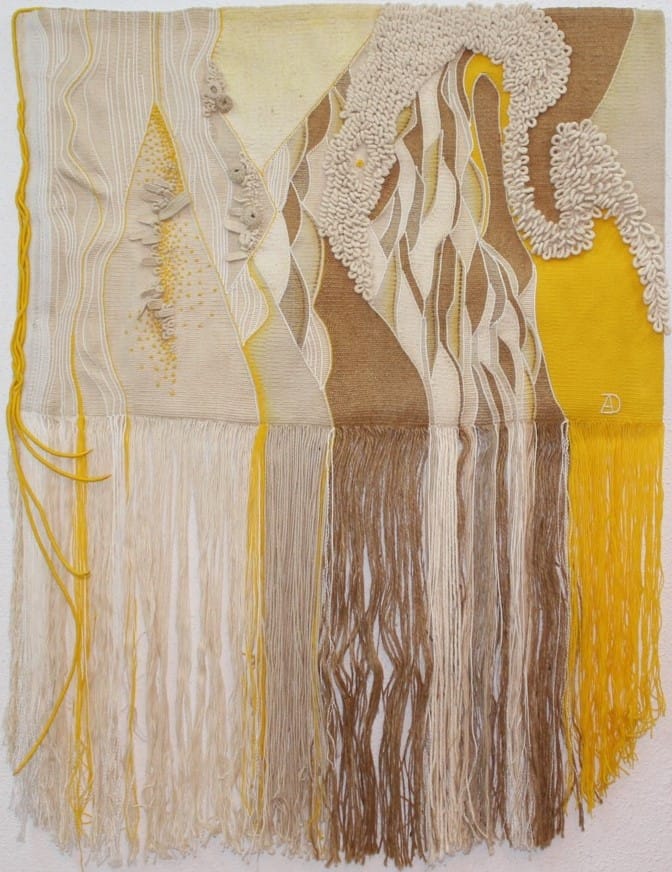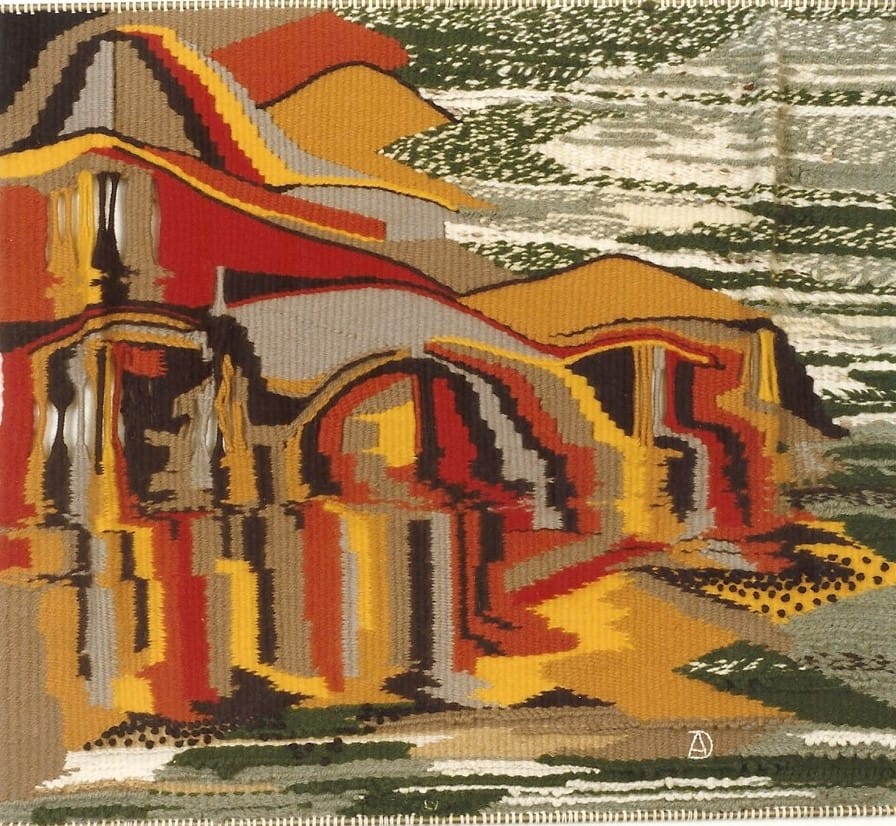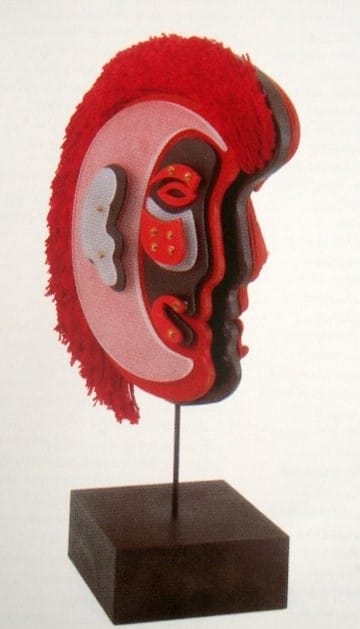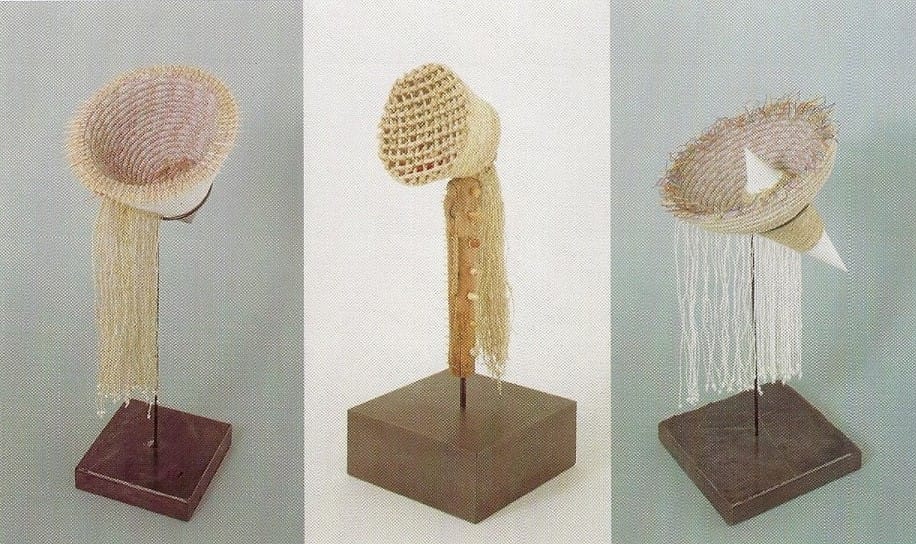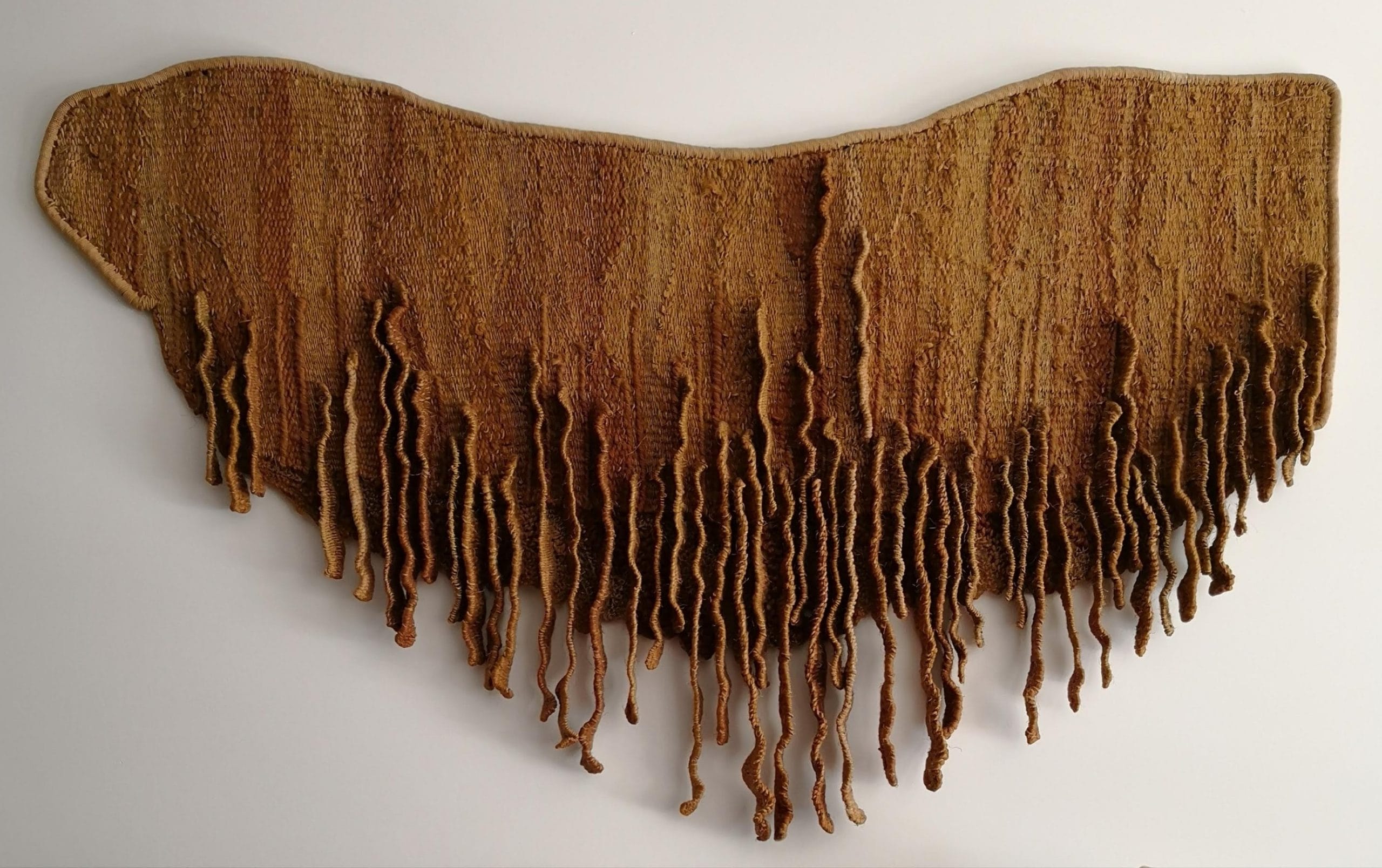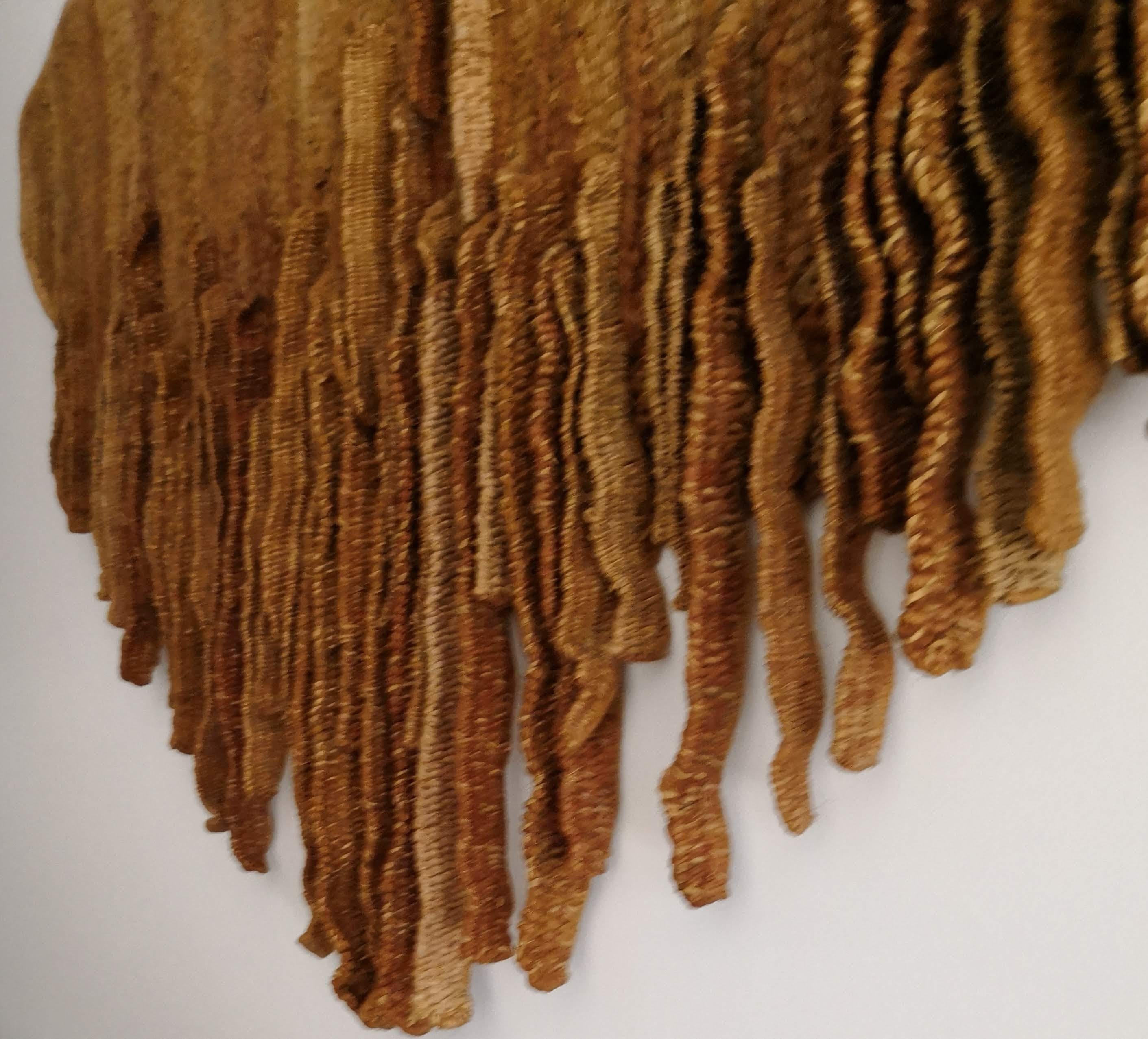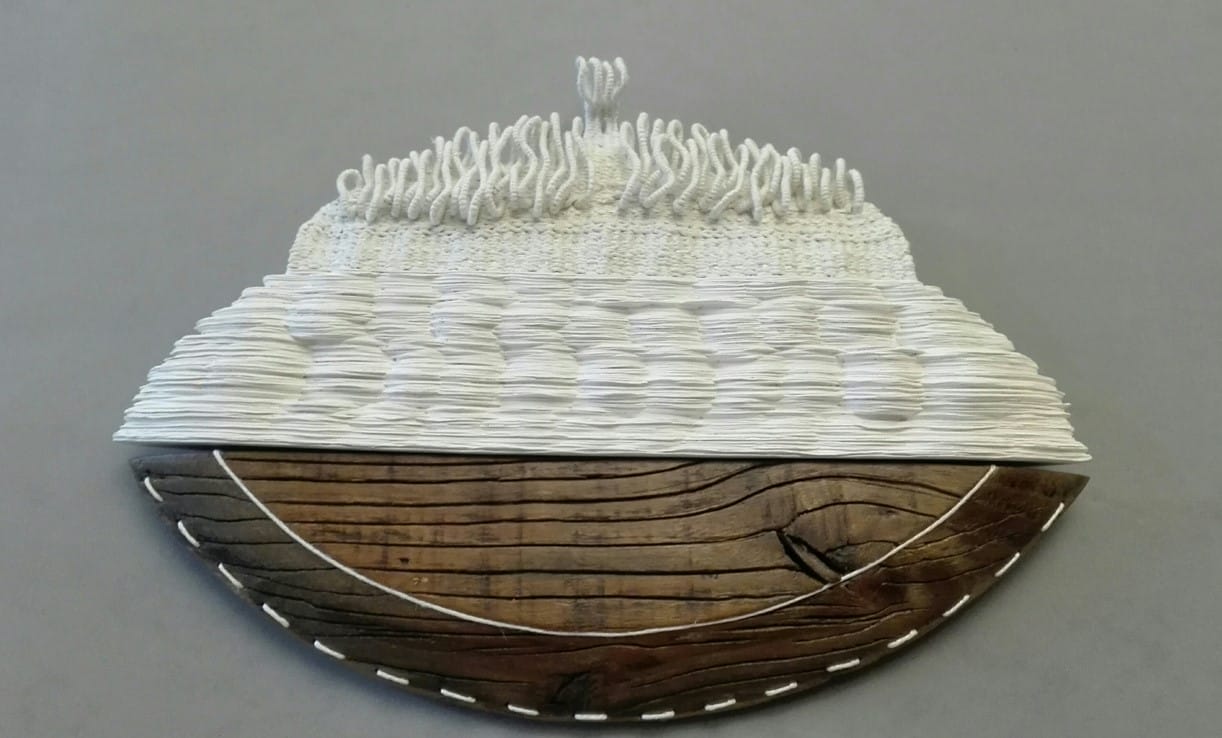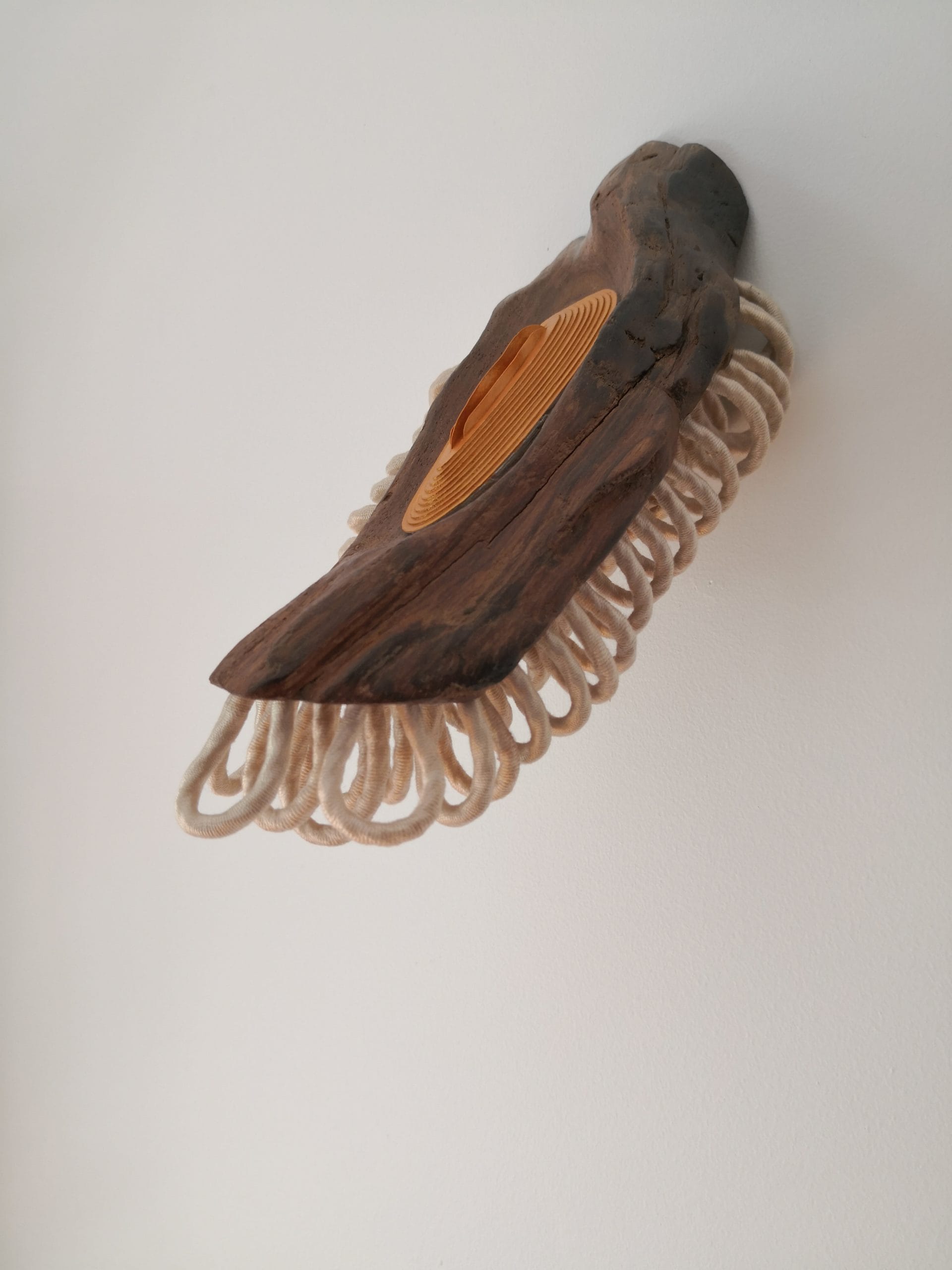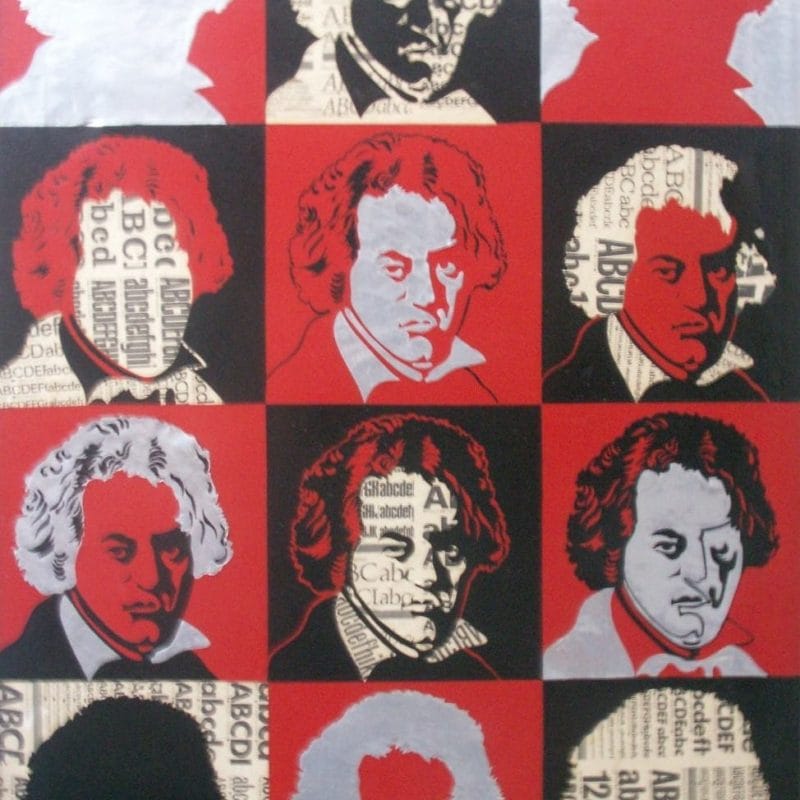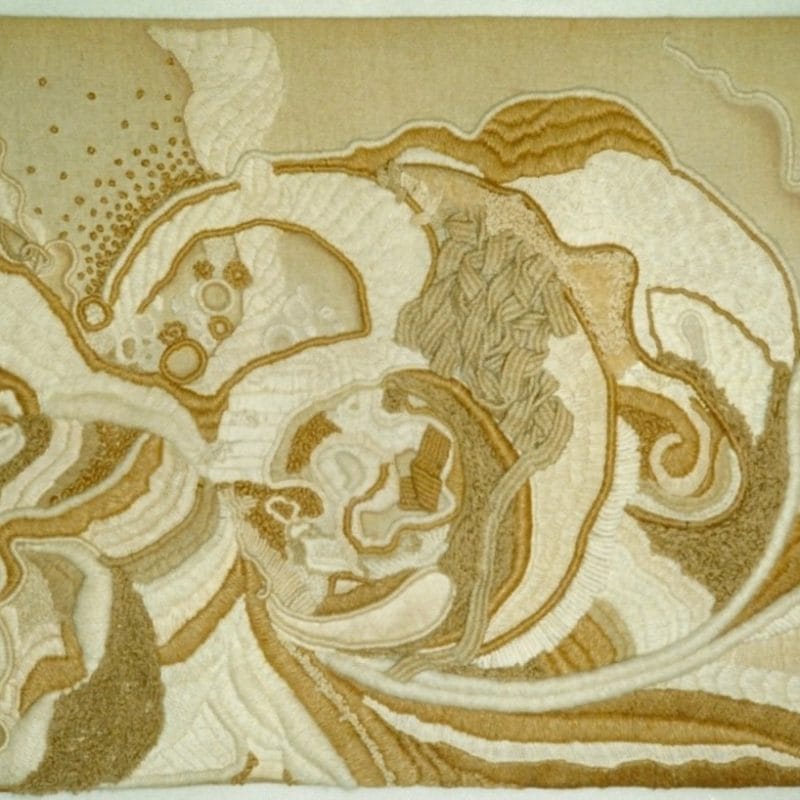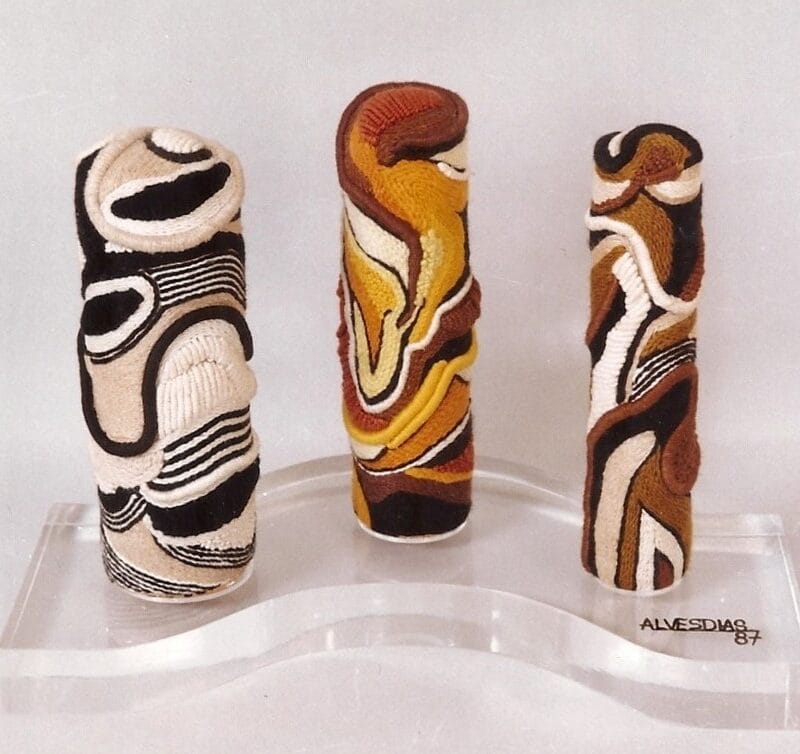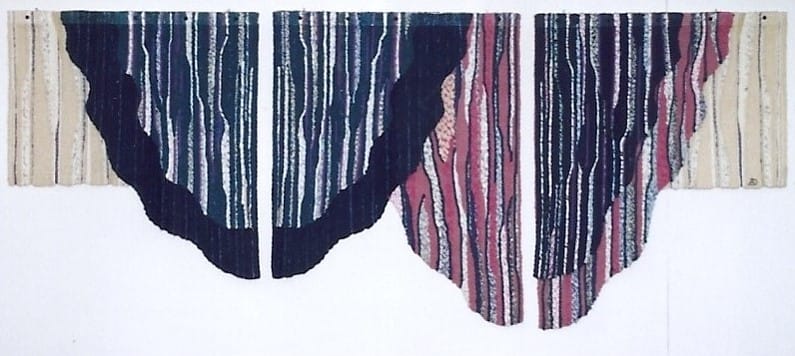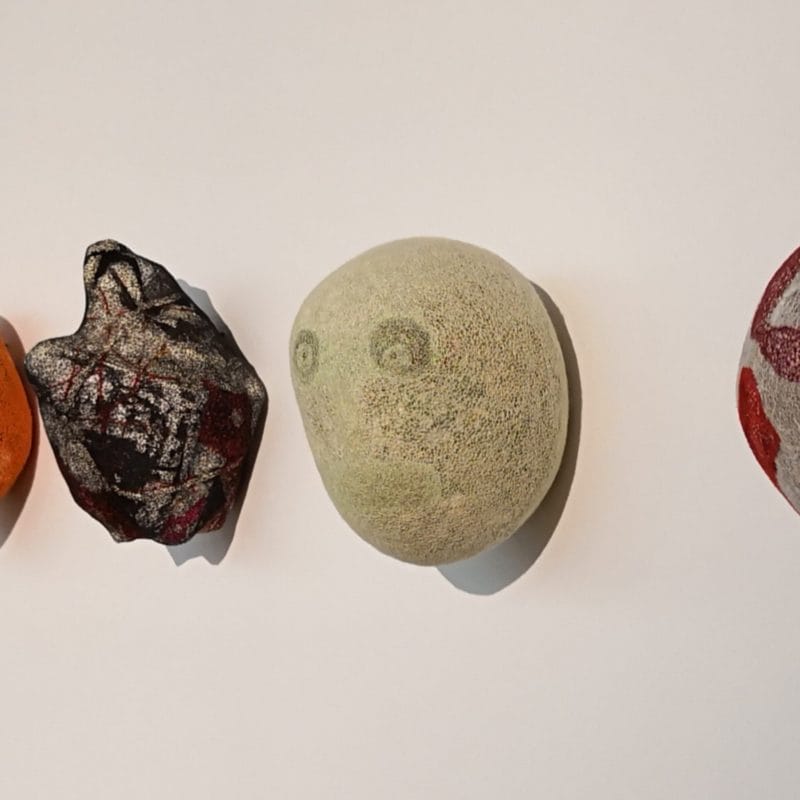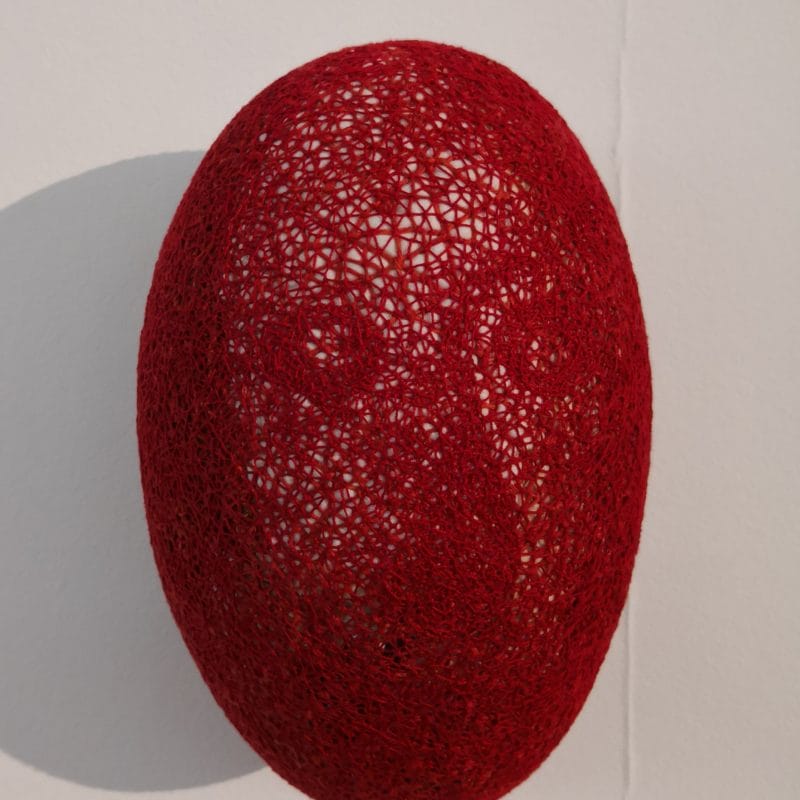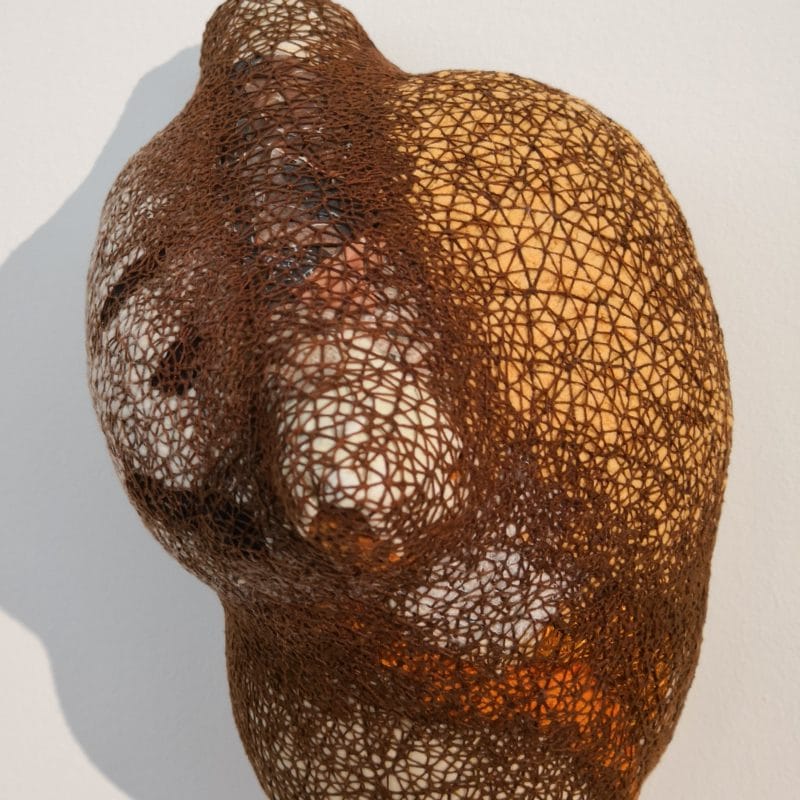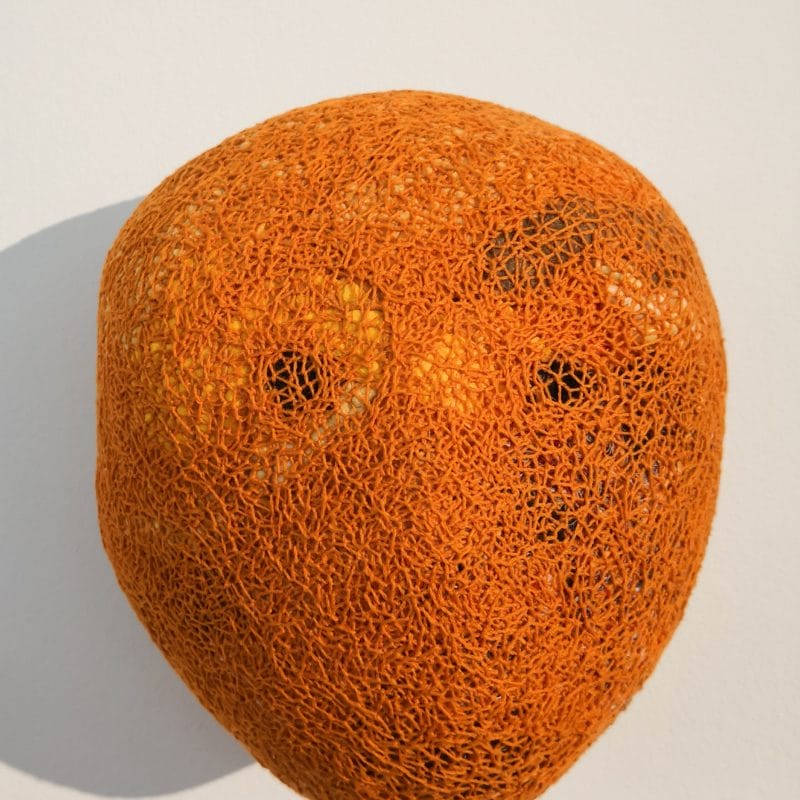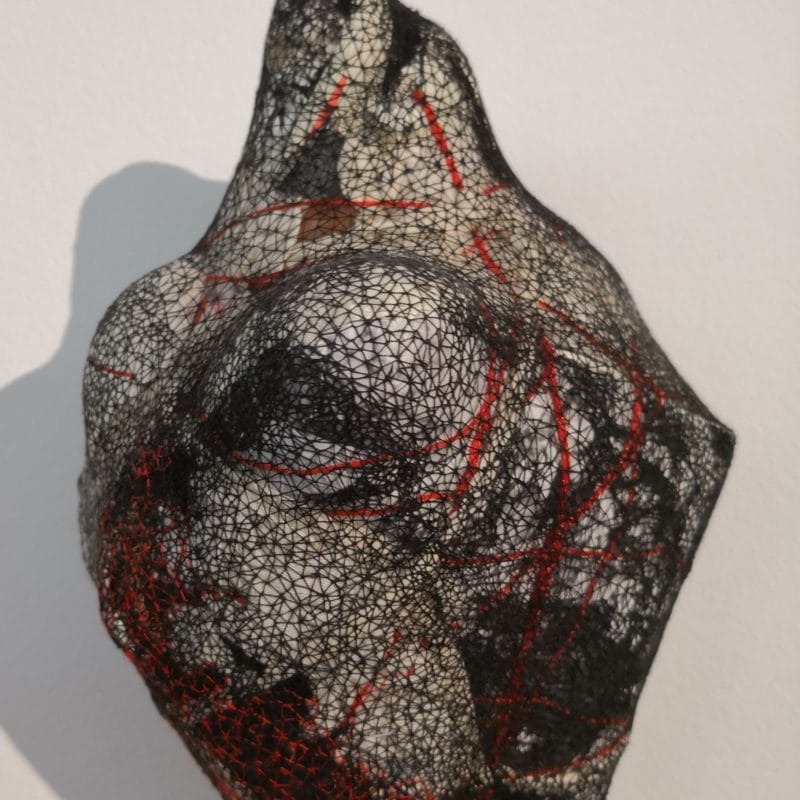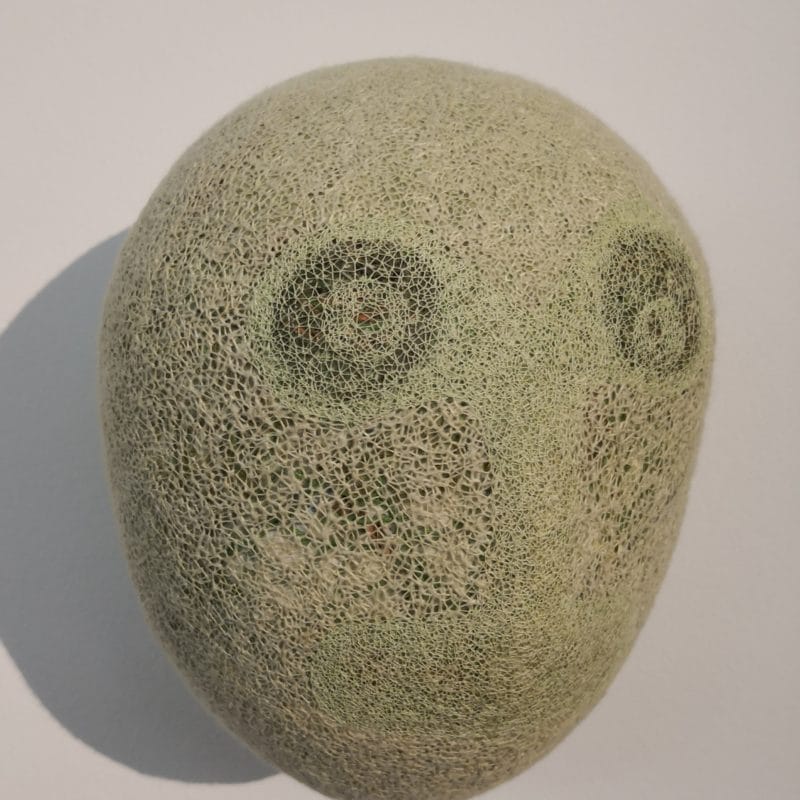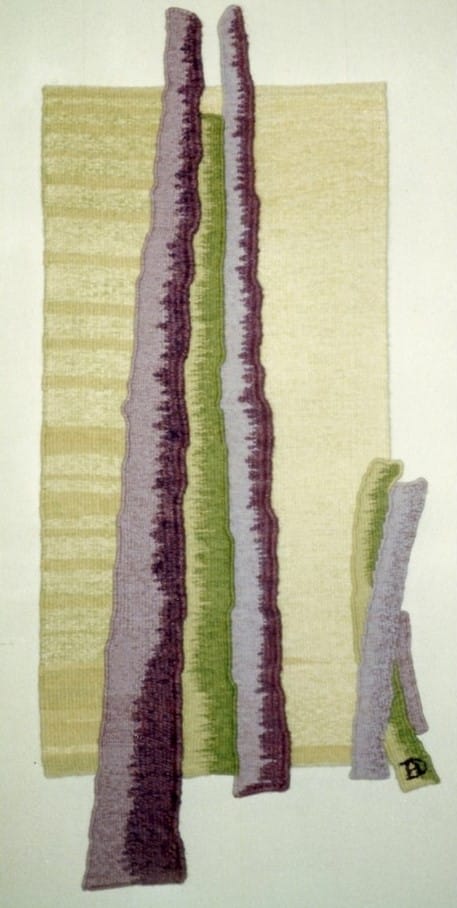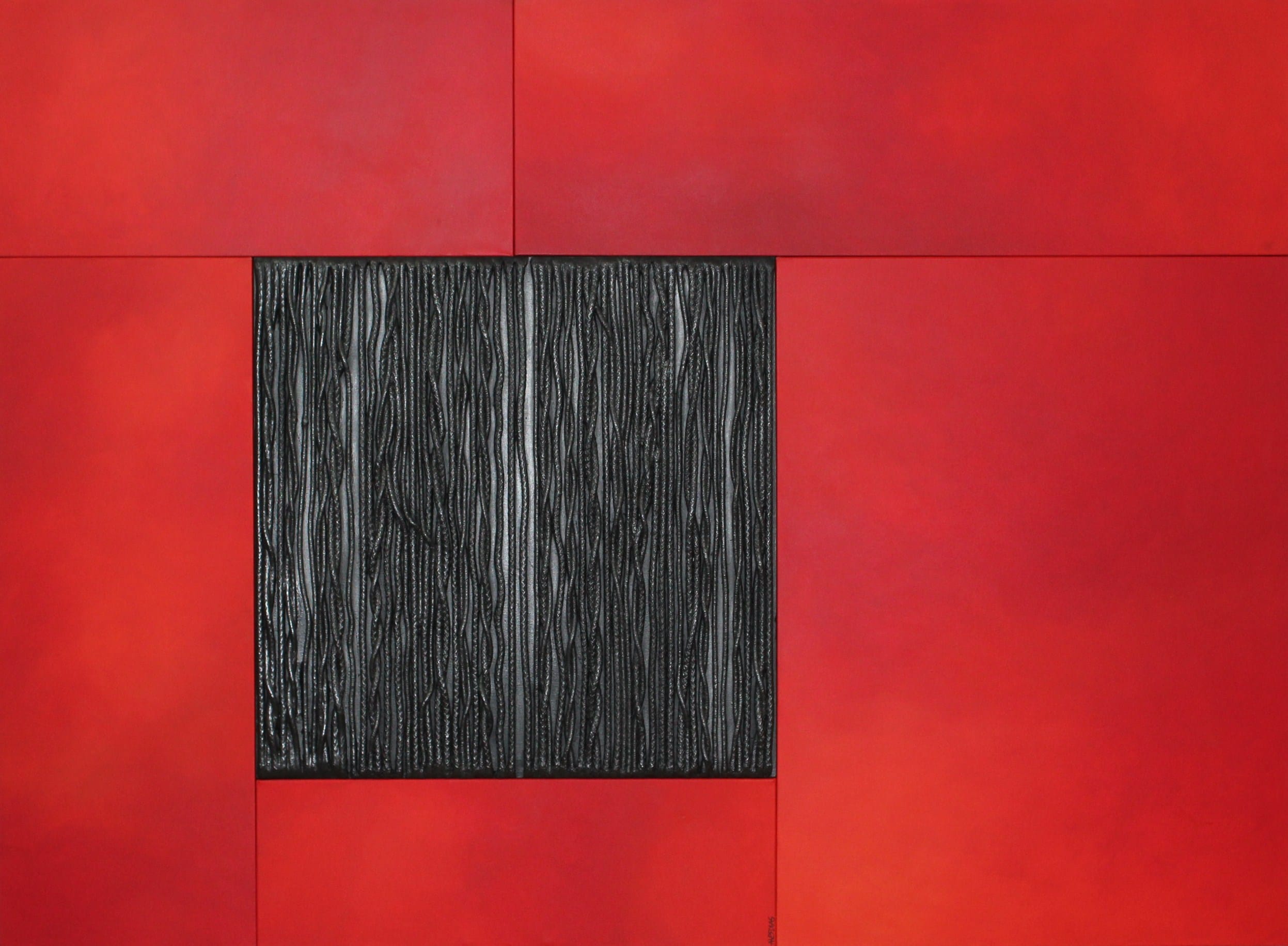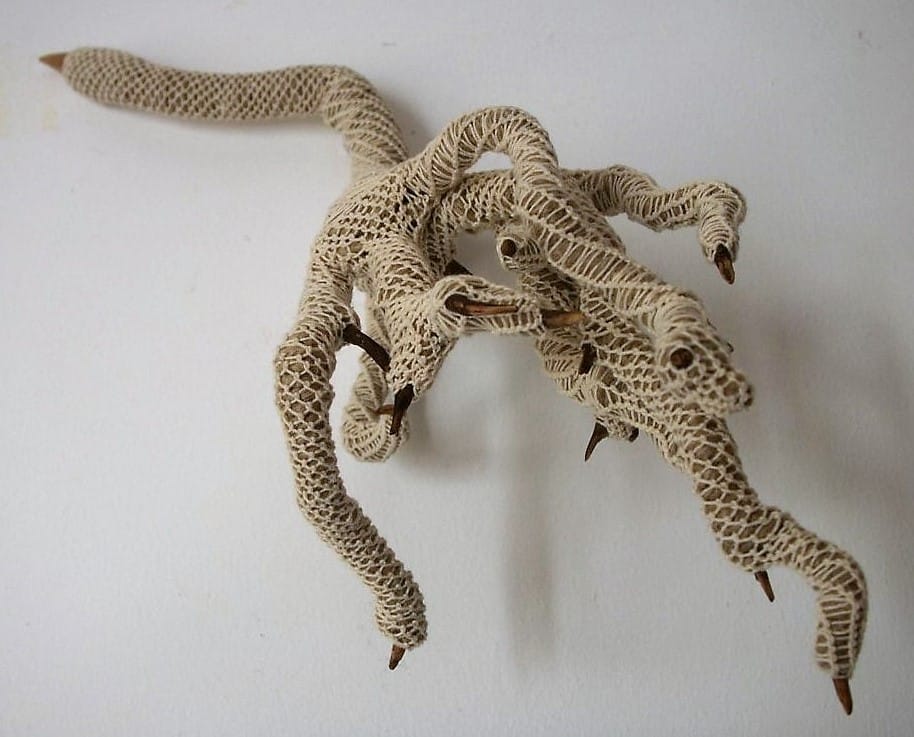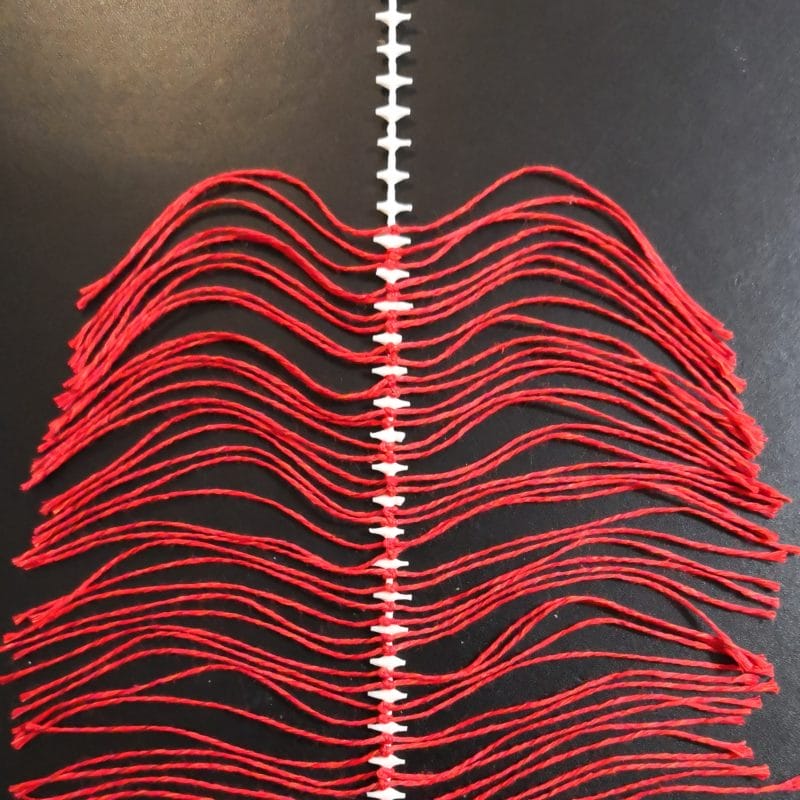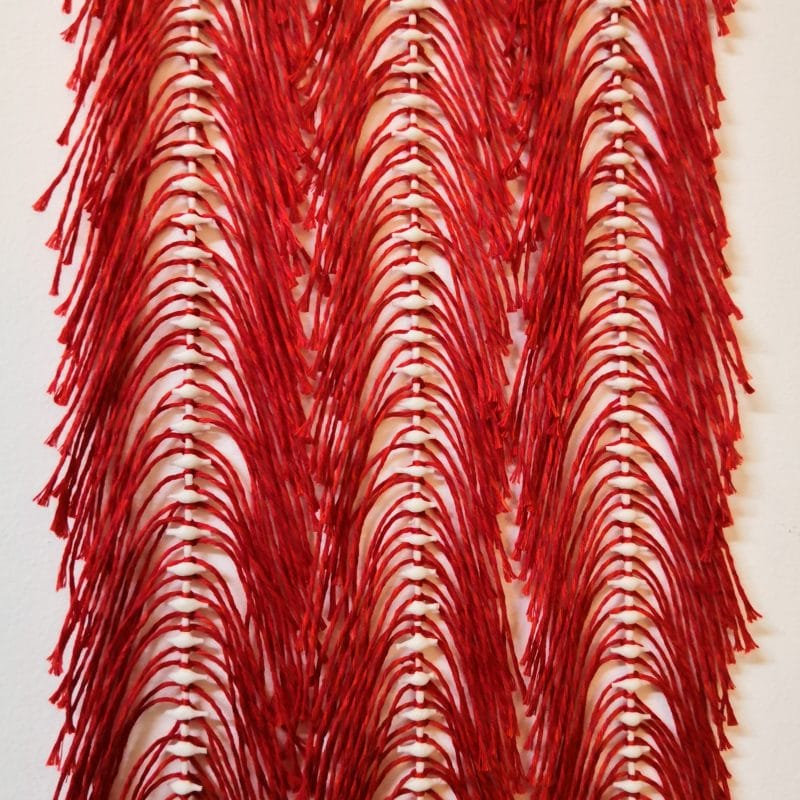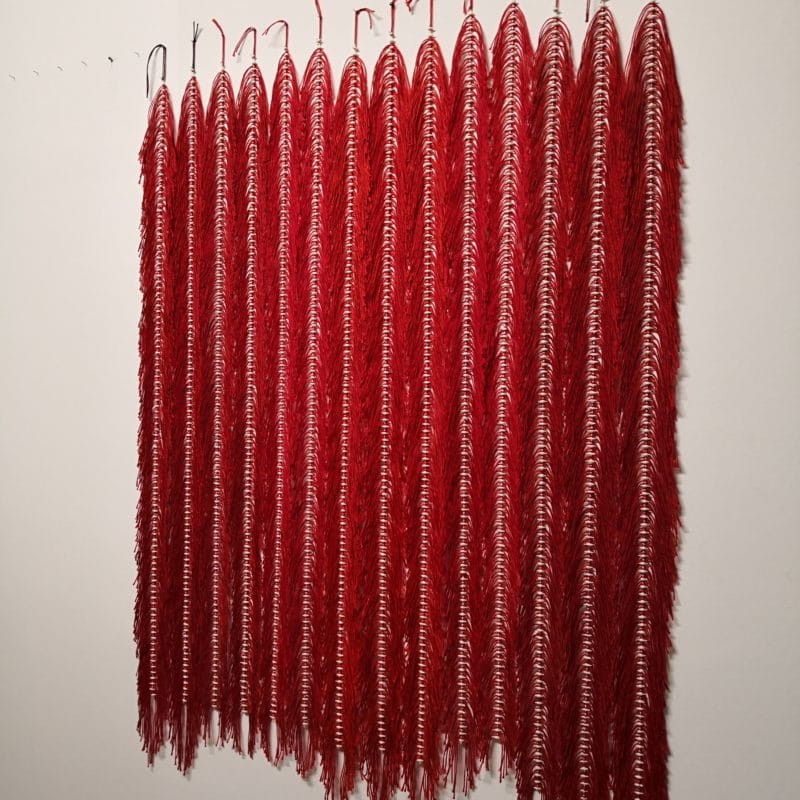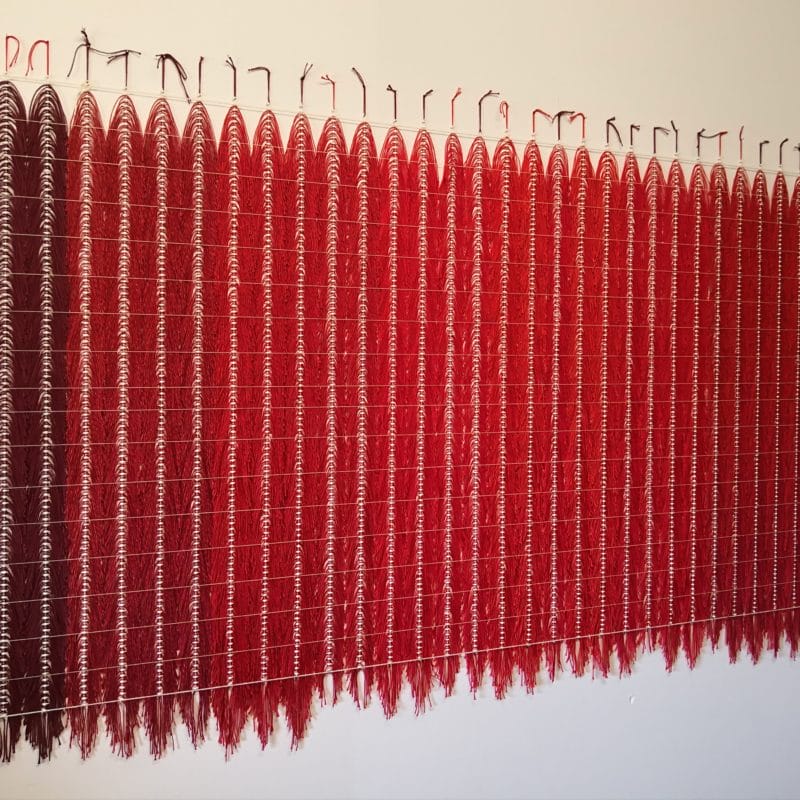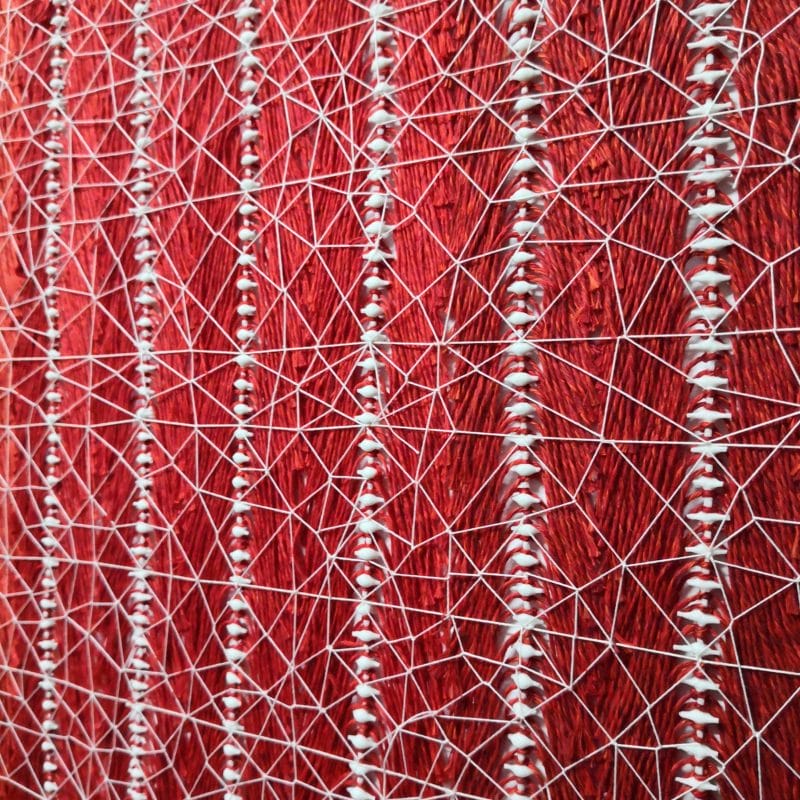The intense dialogue between artist and material: the works by Alves Dias
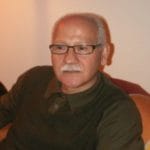
There is a deep bond between Alves Dias and his art, a meditated dialogue that arises from a reflection on artistic creation, on the development of his creative process and the continuous confrontation with the material in which the work is embodied.
His works present a reference to the classic bases of the tapestry tradition, but with a renewed and innovative glance, which shines through his entire work, from the three-dimensional volumes, the choice of composite materials, the overlapping textures and sculptural forms.
Alves, Portuguese painter and textile artist originally from Vila de Rei, was a student of the António Arroio School of Decorative Arts (1972), one of the most significant national educational institutions, with a modern Bauhausian matrix, where painting and textile art have had prominent personalities such as Conceição Salgado, Estrela Faria, Salinas Calado, Teresa Raposo, Rafaela Zuquete, Gisella Santi.
The artist has recently had the honor and merit of representing his country at the eighth edition of the International WTA Contemporary Art Biennial of Textiles, in Madrid, held from October 17th to November 3rd this year.
Below is the link to his website:
https://alvesdias.pt/en/home-2/
Alves, can you tell us something about yourself and your history as an artist, how did you start and why you chose textiles as your main expressive medium?
I was born in a small village, Vila de Rei, the geodesic centre of Portugal. My birthplace fascinates me!Since my boyhood I have been thrilled by the mountain in front of my house covered with the arbutus trees, with a very intense green; a range of colours from yellow to orange and red stood out fromits fruit. I also remember the shadows on the walls of my bedroom when the oil lamp was lit. I recall the gentle blow of the scent of the mimosas, of the rock rose trees and rosemary and I also the stones and loose walls that I climbed and from where I glimpsed my “little world”.
I always watched carefully the various manifestations of Nature as something alive, as something fascinating!
My engagement with the farming life, as well as the bond of sensations associated with the experience of nature in the various rituals like the slaughter of the pig, the olive harvest, the grape hand-pick harvesting , the wheat threshing, and the maize husking were very important experiences for my future life as a plastic artist.
My childhood spent in my village was my first experience of freedom, the school that initiated me and where I learned to watch and imagine my “little world”.
After my primary education I came to Lisbon, the capital of Portugal. This city, its river and the sea were something new to me. It took me some time to taste such beauty! Gradually I discovered Lisbon. This city would be another “new world”, very different from my “little world”, the village where I was born and had lived till then.
I was a dreamy teenager who found at the António Arroio School of Arts one of the first foundations for my paths of art, progress and creativity.
António Arroio School was for me an exceptional school. It provided me knowledge, experiences, techniques and broad experiences for my beginning as a painter and teacher linked to the School Subjects of Drawing and Handwork.
The António Arroio School of Arts was for me a flag of freedom and modernity and it also provided technical education to many artists who are internationally well known now.
I started my activity as a painter after the Painting Course at the António Arroio School of Arts. My early artworks were of an abstract nature and the colour palette ranged from cold colours to warm colours. My first individual exhibition which was very considered took place in 1973, in Abrantes, where I started teaching the year before.
“S/Título”, 1973, Mixed media on canvas (tarlatana, cotton, sand, oil paint), 46x61cm, copyright Alves Dias
A kick-start for my artistic work was my visit to the 8th Lausanne International Tapestry Biennial at the Calouste Gulbenkian Foundation in Lisbon, in 1977. I was astonished with it! I watched those works of art carefully, and I still can shimmer the works of the artists Magdalena Abakanowicz, Olga Amaral, Jagoda Buic, Liselotte Siegfried, Ritzi Jacobi, Dorothy Ruddick and artists Daniel Graffin, Peter Jacobi, Yoichi Onagi, and Tetsuo Kusama. It was, undoubtedly, the visit to this exhibitionthat awakened me to the Textile Art.
Later, as a teacher, Itooka professional internship in 1980 in the areas of Paper, Wood, Ceramics and Textiles.
At that time I already had some knowledge of Tapestry but even though I felt a strong desire to learn new techniques. So Igot in touch with Gisella Santi, a master in Tapestry in Portugal, who had a studio where “new things” were made…
Gisella Santi used to teach the traditional tapestry techniques (the Gobelin) but she also taughtinnovative techniques for Contemporary Tapestry.
Gisella Santi formed theGroup 3.4.5.,a Portuguese Contemporary Tapestry Association in 1978 and I was invited by her to take part of it, in 1989. This Group had a very important role in the promotion of the Portuguese Contemporary Tapestry, by implementing national and international Textile Art exhibitions.
It was in this involvement of looms, webs and weaves and because of the richness of the textile materials that I became interested in Contemporary Tapestry and engaged myself in it.
What is the link between your art, your environment and the cultural of your land?
I have always enjoyed drawing. In the elementary school I used to easily illustrate the compositions and my classmates always asked me to draw for them. As I was very fond of handicrafts I usually mademy own toys out of the trunks of elder trees, from canes, cork, leaves of corn and chestnut. In these small works I already showed some creativity.
At home I enjoyed watching my mother sewing on the old Singer machine as it was she who used to make most of the family’s clothes. I used to watch her attentively to understand how she shaped the fabrics to make the shirts, the pants and the underwear.
In the evenings my sisters usually embroidered, knittedor crocheted while I painted, with crayons,some kitchen utensils, drew the fire that crackled in the fireplace or something else.
The religious festivals and processions, the fairs and rural markets, as well as the different colours and textures of the four seasons of the year always left me sensations and visualizations which I still keep in my memory.
In this context,the village where I was born and lived until I was twelve, left me a wide repertoire of experiences that have been influencing my works, both in painting and tapestry.
In the city of Lisbon and still as a student of the António Arroio School of Arts, the teachers who organized study visits to museums, glass and ceramics factories, as well as to well-known factories as the Portalegre Tapestry Manufacturing Factory and the handmade Arraiolos Rugs Factory, were able to encourage my enthusiasm to visit churches, convents, museums, antique shops and art galleries. They also provided me the knowledge of the aesthetic and artistic sense, the essential basis for my future plastic creations.
Today the city of Lisbon lives in a very intense cultural environment, with a large amount of permanent and temporary exhibitions spread through many museums, foundations, fairs and art galleries. When ever I can I attend these cultural manifestation swhich enrich me and make me fly in order to create webs and threads linked to projects that I still wish to develop.
What makes your tapestries traditional and what makes them contemporary? What is the relationship between tradition and innovation in your artwork?
The first works I made were embroidered tapestries on tow linenfabrics. They are abstract compositions in which the visual elements used to emerge while I was embroidering and choosing the materials I had selected before. At this stage of my work I did not resort to the study of the composition. I could mentally visualize what I wished to do. I used the natural colours of the wool, cotton, linen and jute.
After some time I started to weave in a vertical weaving loom. Some works were made from graphic studies, not others; I just idealized them mentally. As far as the colour is concerned, I used a wide range of colour palette that suited each specific circumstance. I also began to conceive three-dimensional, embroidered and woven works.
My mind wouldn’t stop and I couldn’t stop thinking in order to create and experience other materials and techniques.
During this period my intention was to work with rough and harsh materials and I felt engaged to the natural-coloured vegetable yarns of sisal, jute and hemp of various thicknesses, which I had to colour by dyeing them in a handmade way. I performed larger works with these materials for a long time.
The tapestry language in a traditional dimension (the Gobelin), an essential basis for its creation, is present in almost all of my works.
To create new plastic languages in contemporary concepts, in general, I associate unusual materials combined with innovative techniques. I also use threads which are intendedto be lines of drawing, contours of shapes accentuated by fabrics, collages as a plastic strategy of Modernity among many other procedures which integrate andare part of the body of the work. As I mentioned before the relationship between tradition and innovation is implicit in my work.
The materials have expressive and sensory abilities that can emotionally influence the viewer by conveying specific reactions. When you project a new textile work, what are the criteria, the fundamental aspects that guide you in the choice of materials that you will choose to make it?
When I became to be interested in the execution of textile objects, the profusion of materials took up the space of my desk.
Therefore the textile sensibility acquired other materials such as wires, woods, papers, acrylic glass, plaster, blackboards, wood needles, silver solder, paper pulp, brass plate and copper sheets. Materials always challenge and incite me to take advantage of their properties.
To link some of these materials I often use the gesture of sewing, of joining through the perforation while applying threads which indeed are the true textile fibers. The real or faked sewing is one of the tools I use to create many objects.
I am a gatherer. Whenever I see bits of wood eaten by the worm, small rusty sheets of iron, or other damaged materials, I collect them and I immediately visualize the transformation and the function that I will give them.
When conceiving a new work, my selection of materials is strict and careful and it depends on the expressive, tactile and textural aspects that I wish to give it.
Improvisation, randomness, experimentation, study, rules. Which of these aspects has an essential or prevailing role in the process of the birth of your artworks?
The creative process of my artworks always takes into consideration the thoughtful study of what I wish to do, how to do it and which the rules are for achieving the final product.
In a first step I mentally visualize the entire process of my work development in terms of shapes, techniques, colours and materials. Then I take note of all these data on a sheet of paper. The improvisation, the randomness and the experimentation are also aspects that I appeal to when I want to take advantage of some material that I find to create a work.
I can also choose boxes, drawers and small wooden tables to which I add volumes with various types of malleable materials. Afterwards I embed the textile threads through their intersection. These are the methods I usually use for the creation of my works always considering the conceptual and aesthetic aspects.
How has your work evolved over the years? Are there important stylistic, aesthetic or conceptual differences between your first textile works and the most recent ones?
In my early works the decorative effects were somehow obvious. Through studies, researches and experiences, I succeeded in breaking free of these effects and tried to highlight the conceptual and aesthetic sense of the works by using the three-dimensional tapestry, the creation of volumes and the surrounding spaces.
My work has evolved a lot. The different methodologies, the techniques, the materials, the application of the most various textures were the fundamental basis for the improvement of my work.
My attentive reading of specialized books on textile and contemporary tapestry, the lectures, the workshops, the visits to international art fairs, the textile biennials and the exchange of ideas with other artists have been also relevant to me.
It is evident the achieved evolution between the accomplishment of my first works and those that I am carrying out now. We can visualize the growth on the aesthetic and conceptual level and my concern with achieving procedures so that the language of traditional tapestry is not implicit.
What is the source of your inspiration today?
Everything that surrounds me can be a source of inspiration: the nature, the memories and scents of my childhood as well as the sensations and visual stimulien couraged by the past and everyday experiences.
I am a very creative person and I find suggestions in the smallest things, even a piece of wood or iron destroyed by the time can lead me to theexecution of an artwork. The dialogue between my hands and the material understand each other and they conceive the work itself.
My careful observation of some works of art in museums and exhibitions as well as the application of images of other artists’ works can lead me to interpretations in order to perform new works. But it is the most diverse materials that challenge and urge me to explore new concepts, to go further in this wonderful world of textile art.
Can you tell us about your work Velaturas Têxteis which is exhibited at the Eighth Biennial of Contemporary Textile Art WTA in Madrid?
I created these works from a set of textile materials where the threads prevail in order to generate new plastic languages in contemporary concepts.
The work “Velaturas Têxteis”, composed of six elements, was designed not to identify itself with the canons of the traditional tapestry language. My goalwas also to achieve procedural freedom for the treatment of the surfaces.
From my idea of wishing to generate various three-dimensional shapes, I modelled various textile materials as if they were a piece of clay. These shapes were born from the compression of various materials such as fabrics, paper, wastes of various textile fibers and linen and also raw cotton. They were tied by cotton yarns of various thicknesses to give them the intended shapes.
I used the expression “velatura”, a pictorial technique in which several layers of transparent ink are overlapped. In this textile situation, I used and cotton and linen yarns of several thicknesses in a technique where the crossing of multiple yarns let the materials that I used to be seen. In this context, the thorough spreading of the intersected wires, sometimes dense, creates sometimes more and sometimes less compact textures and they highlight the effect of transparency, as if they were glazes.
This work was selected for the International Contextile Biennial in Guimarães, in 2018 and with it I was elected to represent my country, Portugal, as a guest artist for the 8th WTA International Biennial of Contemporary Textile Art, in Madrid, in 2019.
On the basis of your rich and many years of experience as an artist and teacher, what is the space that textile art has today within the wider field of the Major Arts? Has textile art finally managed to win the right to no longer be considered a minor art?
Contemporary Textile Art, as a mean of plastic expression, since the sixties, has been exploring new ways, new concepts and new experiences. By leaving its traditional status, the Textile Art has been increasingly proving its destiny like all the other forms of Art. The Textile Art already left the wall, took physically space, waived the loom and resorted to new techniques and new materials.
In the last decades the Textile Art has been going through many renovations. Starting from traditional techniques many artists have developed new contemporary proposals with innovative techniques, from the weaving in digital photography to the 3D printing, the organic textile, the video, the installation and so on
Textile Art is no longer considered a minor art, it is rather a major art which has increasingly been viewed around the world, in the main international art fairs, art galleries and biennials.
Alves, among all the tapestries you have made so far, the subjects or concepts they represent, is there a red thread that keeps them together as if they were a universal, unique work? In other words, is there a principle that inspires and founds all your tapestry production?
In all the works I have created for more than four decades of artistic activity in which the textile-tapestry element is always present and inherent to drawing and painting, there is a common thread that sustains the whole creation: the materials and techniques associated with the conceptual and aesthetic component are the ones that set up all my work. It is also my eyes and my fingers that connect and understand themselves in this relationship of sensuality with the materials that surround me. Thoughts also generate in me silences made of deep observations that reflect in the creation and materialization of my almost tactile works.
In your opinion, what are the expressive limits of textile art?
Now a days there are no limits to the creation of the Textile Art. Everything is suitable to weave, everything is webs and plots without really being it.
The textile sensitivity trespasses the most diverse materials and techniques and it can disregard the conventional and structural concepts of weaving. To this extent, every things suitable to weave, to interweave, to bind, to cover and to roll up, and it is this that establishes a dialogue between shapes and textures. The work is born this way…
In this path of webs and plots we are finding spaces of dialogue to discover the capacity of the textiles as an artistic means of expression and so weare creating new plastic languages in contemporary concepts.
What are you working on right now? Would you like to tell us about your current textile projects and upcoming exhibitions?
Now I am working in a piece that will be exhibited, hanging. My idea for its achievement came from the visualization of a malleable polyester structure with small squares which is used to be placed underneath the carpets so that they do not slide. This work is made up of forty-one strips of polyester which were cut from the square structure. The strip is ninety centimetres long and I have tied cotton threads to each strip. Altogether they are eight thousand, two hundred and eighty-two threads! After having tied all the wires to the strips, they were fastened to the wall with nails. Then I fastened the strips together to fix them. My goal is that the knotted threads can be seen under the web. This it is made by the intersection of several threads. As the work will be hanged, I will work on it from the other side. I will create reliefsthere, in paper or fabrics and I will cover the surface created with the same web of crossed threads. This process will take me much time.
In the near futureall my textile creation will go through the realization of three-dimensional projects, materialized with innovative techniques.
I will participate in several group exhibitions and I highlight the one I will engage with at the Portalegre Tapestry Museum – Guy Fino, Portalegre Tapestry Manufacturing, with the teachers and students of the Faculty of Fine Arts of the University of Lisbon. I will also compete for the International Biennial of Contemporary Textile Art, theContextile 2020, in the city of Guimarães. I also intend todevelop projects for individual exhibitions in Cultural Foundations, Museums and Art Galleries at national and international levels, from the year 2021.
It is in this my “Little World” of threads and lines, crossed with silences, quietness, aloneness and serenity that I build webs and plots in a deep dialogue with the hands, the materials and techniques. This manual time is unified, it is my time and I accept what my hands do and what they can do!


